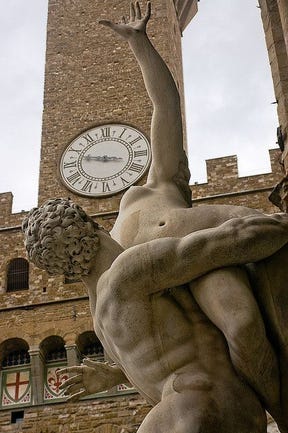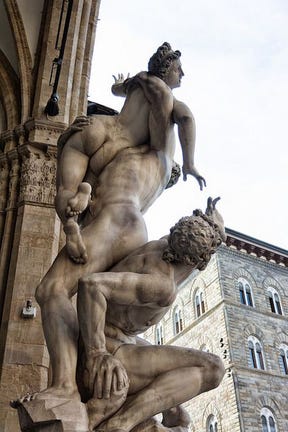A Spiral of Drama in Marble
Giambologna’s Rape of the Sabine Women, 1583
If you’ve ever stood in Florence’s Piazza della Signoria, beneath the open arches of the Loggia dei Lanzi, you’ve likely felt the magnetic pull of Giambologna’s Rape of the Sabine Women.
This towering marble sculpture doesn’t just stand there — it moves.
It writhes, twists, and commands your gaze, pulling you into a frozen moment of chaos and beauty.
The sculpture draws from Roman mythology, specifically the abduction of the Sabine women by Romulus and his men to populate their fledgling city. It’s a violent tale, no question — yet Giambologna transforms this brutal narrative into a breathtaking study of form and emotion.
Created in 1583, the work isn’t about glorifying the act but showcasing the raw, human struggle within it. The title ‘rape’ carries the archaic Latin sense of rapere (to seize), but the modern connotation can’t be ignored. It’s a piece that forces us to grapple with beauty and discomfort in equal measure.
What makes this sculpture unforgettable?
Its spiraling composition.
Three figures — a crouching man, a lunging abductor, and a woman reaching skyward — interlock in a dynamic, almost serpentine dance. You can’t view it from one angle, it begs you to circle it, each step revealing new tensions, new gestures.
This is Mannerism at its peak: elegance, exaggeration, and emotional intensity over classical restraint.
Giambologna: The Flemish Virtuoso in Florence
Born Jean Boulogne in Flanders, Giambologna (1529–1608) became the Medici court’s go-to sculptor, blending Northern European precision with Italian flair.
By the time he crafted Rape of the Sabine Women, he was a master of figura serpentinata — the ‘serpentine figure’ that twists in space, creating a sense of movement.
This wasn’t just a flex of technical skill (though carving three figures from a single marble block is no small feat). It was a bold statement: sculpture could rival painting in storytelling and drama.
Giambologna didn’t set out to depict the Sabine myth.
The sculpture began as a technical exercise, a challenge to push marble to its limits. Only later did it gain its narrative title, likely to align with the Medici’s love for classical themes.
Art, meet politics.
Share Cultural Canvas with those who appreciate art's intricacies. Let's keep exploring the fascinating stories behind masterpieces.
Why It Still Captivates
Walk around the Rape of the Sabine Women, and you’ll feel the figures’ desperation.
The woman’s outstretched arm, straining for freedom. The abductor’s taut muscles, mid-stride. The defeated man at the base, his body contorted in anguish. Giambologna captures not just bodies but moments — fleeting, visceral, human.
The marble seems to pulse with life, a testament to his ability to make stone feel like flesh.
This sculpture also challenges us. Its beauty is undeniable, but its subject matter is troubling.
How do we reconcile the two?
In 1583, the Medici displayed it publicly to awe and inspire. Today, it sparks conversations about power, gender, and the ethics of art.
That tension is why it endures — not as a relic, but as a living dialogue.
If you’re in Florence, head to the Loggia dei Lanzi. Stand beneath the arches, let the crowds fade, and take in the sculpture’s dizzying energy.
Notice how the light catches the curves, how each angle shifts the story.
Then, pop over to the nearby Bargello Museum to see Giambologna’s smaller bronze works for a deeper dive into his genius.
Giambologna’s Rape of the Sabine Women isn’t just a sculpture, it’s a performance in stone, a 400-year-old whirlwind of emotion and craft. It reminds us that great art doesn’t just sit pretty — it provokes, it moves, it lives.





